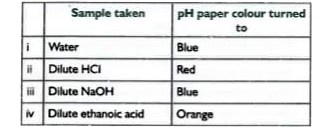Complete Solutions to ZEN ADDITOINAL QUESTIONS SECTIONS (MULTIPLE CHOICE QUESTIONS) of chapter ACIDS, BASES, AND SALTS of Class 10 book with complete answers and questions
| Class 10 | CHEMISTRY |
| Chapter | ACIDS, BASES, AND SALTS |
| ZEN PUBLICATION | ZEN ADDITOINAL QUESTIONS SECTIONS (MULTIPLE CHOICE QUESTIONS) |
| Number Of Questions | 28 |
| Academic Year | 2023-24 |
A student prepared 20% NaOH solution in a beaker containg water. The observation made by him are as follows :
(i) NaOH are in the form of pellets.
(ii) It dissolves readily in water.
(iii) The beaker appears cold from outside.
(iv) Red litmus paper turns blue when dipped in the solution.
The correct observation are :
View SolutionIn an experiment to test the pH of a given sample using pH paper, four students recorded the followig observations :

Which one of the observation in correct ?
View SolutionWhen a student added zinc granules to dilute HCl, a colurless and odourless gas was evolved. When it was tested with a burning match stick, it was observation that :
View SolutionOn adding acetic acid to `NaHCO_(3)` in a test tube , a student observes
View SolutionSelect the correct pair of properties of acetic acid.
View SolutionAn aqueous solution turns red litmus solution blue. Excess addition of which of the following solution would reverse the change ?
View SolutionDuring the preparation of hydrogen chloride gas on a humid day, the gas is usually passed through the guard tube containing calcium chloride. The role of calcium chloride taken in the guard tube is to
View SolutionWhich of the following salts does not contain water of crystallisation ?
View SolutionSodium carbonate is a basic salt because it is a salt of
View SolutionCalcium phosphate is present in tooth enamel. Its nature is
View SolutionA sample of soil is mixed with water and allowed to settle. The clear supernatant solution turns the pH paper yellowish-orange. Which of the following would change the colour of this pH paper to greenish-blue ?
View SolutionWhich of the following gives the correct increasing order of acidic strength ?
View SolutionIf a few drops of a concentrated acid accidentally spills over the hand of a student, what should be done ?
View SolutionOne of the constituents of baking powder is sodium hydrogencarbonate, the other constituent is
View SolutionTo protect tooth decay we are advised to brush our teeth regularly. The nature of the tooth paste commonly used is
View SolutionThe pH of the gastric juices released during digestion is
View SolutionWhich one of the following can be used as acid-base indicator by a visually impared student ?
View SolutionWhich of the following substance will not give carbon dioxide on treatment with dilute acid ?
View SolutionWhich of the following is acidic in nature ?
View SolutionWhich of the following is used for dissolution of gold ?
View SolutionWhich of the following is not a mineral acid ?
View SolutionWhich among the following is not a base ?
View SolutionWhich of the following statements is not correct ?
View SolutionEqual volumes of hydrochloric acid and sodium hydroxide solutions of same concentration are mixed and the pH of the resulting solution is checked with a pH paper. What would be the colour obtained ? (You may use colour guide given in the Exemplar book.)
View SolutionWhich of the following statements is true for acids ?
View SolutionWhich of the following are present in dilute aqueous solution of hydrochloric acid ?
View SolutionIdentify the correct represents of reaction occurring during chloralkali process
View SolutionAs the pH value of a neutral solution increases
View Solution
ZEN ADDITOINAL QUESTIONS SECTIONS (MULTIPLE CHOICE QUESTIONS) questions and complete solutions for chapter ACIDS, BASES, AND SALTS of ZEN CHEMISTRY (KANNADA ENGLISH) of Class 10
All Exercises from ZEN PUBLICATION Class 10 CHEMISTRY ACIDS, BASES, AND SALTS
- Questions Sections (In-Text Questions)
- Questions Sections (Textual Exercise)
- ZEN ADDITOINAL QUESTIONS SECTIONS (Long Answer Type Questions)
- ZEN ADDITOINAL QUESTIONS SECTIONS (MULTIPLE CHOICE QUESTIONS)
- ZEN ADDITOINAL QUESTIONS SECTIONS (Short Answer Type Questions - I)
- ZEN ADDITOINAL QUESTIONS SECTIONS (Short Answer Type Questions -II)
- ZEN ADDITOINAL QUESTIONS SECTIONS (Very Short Answer Type Questions )